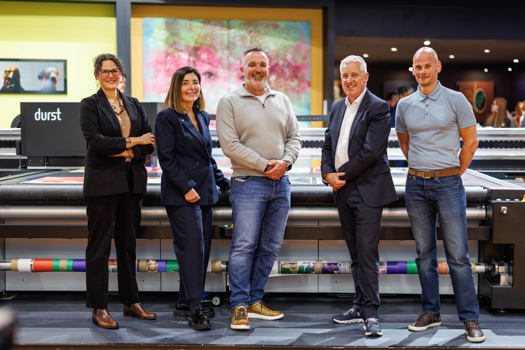What does it do?
This is claimed to be the world’s fastest cut-sheet A3 inkjet printer, able to output 320 A4 sheets per minute with duplexing at full speed. It’s a twin engine duplex version of Riso’s 160ppm Comcolor GD9630.
The throughput works out as 9,600 duplex A3 sph, which lets Riso claim the T2 is touching offset speeds – true enough if you compare it with a non-perfecting five-unit press doing double-sided jobs.
We haven’t been able to compare print quality, but Riso’s use of oil-based inks suggests it will work with a greater range of standard paper finishes than the more usual water-based inkjets. Riso says there’s no soak-through and the inks dry quickly without heat.
The T2 handles lighter weights than most toner based digital presses (from 46gsm), but the maximum of 210gsm isn’t up to the 300 and 350gsm that is becoming common for toner presses, let alone offset. This doesn’t matter for the target market of document printing, but it means it won’t be handling business cards or card covers.
When was it launched and what markets is it aimed at?
A prototype was shown at Drupa 2016, and the production model was launched earlier this year. Riso says it is aimed at the high-end production print and transactional markets, saying “The T2 offers a real opportunity to meet the needs that traditional offset and toner technologies cannot meet by offering high-speed variable data at a competitive price, all with a low capital investment.” It expects the majority of work to be on A4 cut sheets.
Riso also claims green credentials for the ‘cold printing’ T2 in that its power consumption is less than toner presses, as it doesn’t need the heated fuser stage. The use of oil-based ink seems to explain why there’s no need for the power hungry driers. There are said to be no harmful emissions (VOCs) or ozone generation either. We haven’t been able to find out comparative ink costs, but Riso says: “We offer the most competitive pricing in the full-colour cut-sheet inkjet print market.”
How does it work?
The T2 is comprised of two GD9630 five-colour print engines inline linked by a switchback unit, with high-capacity feeder and stacker units. There are no inline finishing functions or options so far.
The fifth colour is grey, used to smooth out mid-tones, give denser blacks and enhance colour stability, apparently through grey component replacement. This is common in large-format inkjets but is unusual in production presses.
According to Riso, its Forcejet single-pass inline inkjet technology ensures maximum uptime. “Paper is not exposed to any heat source, which reduces the risk of paper misfeeds. Paper is also delivered flat which is ideal for printing and post-print processes,” it says. Like all Riso machines, the T2 is compatible with uncoated stocks.
The High Capacity Feeder takes 4,000 sheets. With use of multiple trays, this allows 5,500 sheets of paper to be loaded for continuous feeding.
The High Capacity Stacker can be set to stack face up or face down and can offset document sets for easier removal and finishing. A High Capacity Stacker Cart is also offered to aid paper handling from printer to finisher.
Riso also describes the RIP as “exceptionally powerful,” which is needed to run fully variable data at full speed in five colours. It’s an Alphastream controller running on a Dell Precision T5810 workstation. In keeping with the transactional target markets, it supports AFP/IPDS input formats for variable data as well as PDF and PostScript workflows.
Does it replace anything?
No, the T2’s configuration is unique in the Riso range. At Drupa Riso also showed the even faster roll-fed T1 concept, which it says is still in development.
What’s the USP?
Mainly the speed, although the oil-based ink is unusual and probably unique in this market. The company also points to the fairly small footprint (3.7mx720mm).
How easy is it to use?
“The T2 is very easy to handle, and does not require any special skills or training to take advantage of its capabilities,” says print production manager Dinis Cachao.
What training and support is on offer?
“Full training will be provided to all users and service will be provided by Riso technicians, as the product is being sold initially through our direct channel only,” says Cachao.
What’s the throughput?
As above, 320 A4ppm, with a rated monthly capacity of 1 million pages.
What does it cost?
Approximately £120,000. There are click charges and customers are able to choose either ink inclusive or ink exclusive options.
What’s the installed base?
None in the UK so far, though Cachao says “several discussions are taking place.” The first European T2 recently went to a Netherlands direct marketing agency, DM+ in Zoetermeer.
SPECIFICATIONS
Process Drop-on-demand inkjet with oil-based pigment inks
Speed 320 A4 duplex spm, 160 A3 duplex spm
Rated monthly capacity 1 million A4 pages
Max sheet size 340x460mm
Min sheet size 148x210mm
Stock weight range 46–201gsm (High Capacity Feeder), 52–104gsm (feed tray)
Colours CMYK, Grey
Resolutions Standard: Black 600x600dpi, CMYG 300x300dpi; Fine: Black 600x600dpi, CMYG 300x600dpi
Data input formats AFP, IPDS, PDF, PostScript
Footprint 3.4mx720mm
Weight 610kg
Price Approx £120,000
Contact Riso UK 020 8236 5800 www.riso.co.uk
ALTERNATIVES
Canon Océ Varioprint i300
Launched in 2015 but improved just before Drupa 2016, this B3 single-engine inkjet press costs several times more than the much faster Riso T2, but it is more of an all-round commercial machine, with higher rated duty cycles. It supports greater maximum paper weights (on litho stocks too) as well as offering inline finishing options.
Process Drop-on-demand piezo inkjet with water-based pigment inks
Paper sizes From 203x203mm to 488x320mm; With optional guide: 178x254mm; With PIM-XL: 353x500mm
Speed Up to 300 A4 images/minute or 106 duplex A3 images
Stock weight range 60–300gsm
Footprint 10.2x2.8m
Price £750,000 depending on configuration
Contact Canon UK 0870 600500 www.canon.co.uk
Xerox Brenva HD
Brenva is Xerox’s fastest cut-sheet press, and like the T2 it’s an inkjet. However the price point is significantly different, as it offers more automation, variable drop sizes, much greater monthly capacity and closed-loop colour controls. Brenva’s top speed is just 275ppm due to its single engine, despite a recent speed boost thanks to a new duplexing unit. Brenva has also just seen an increase in its rated maximum paper weight, up from 197 to 275gsm, and it’s gained a Tecnau roll feed option.
Process Drop on demand piezo inkjet with water based inks
Colours CMYK
Max sheet size 364x520mm
Speed 197 A4 simplex images per minute
Stock weight range 60–220gsm
Price About £463,000 with DFE, stacker and input module
Contact Xerox UK 0870 873 4519 www.xerox.com










